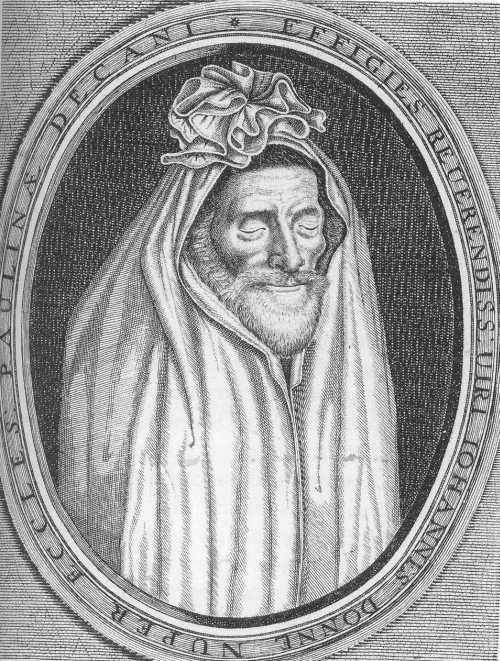
Who ever comes to shroud me, do not harme
Nor question much
That subtile wreath of haire, which crowns my arme;
The mystery, the signe you must not touch,
For ’tis my outwarde Soule,
Viceroy to that, which then to heaven being gone,
Will leave this to controule,
And keepe these limbes, her Provinces, from dissolution.
For if the sinewie thread my braine lets fall
Through every part,
Can tye those parts, and make mee one of all,
Those haires which upward grew, and strength and art
Have from a better braine,
Can better do’it ; except she meant that I
By this should know my pain,
As prisoners then are manacled, when they’are condemn’d to die.
What ere shee meant by’it, bury it with me,
For since I am
Loves martyr, it might breed idolatrie,
If into other hands these Reliques came;
As ’twas humility
To afford to it all that a Soule can doe,
So, ’tis some bravery,
That since you would have none of mee, I bury some of you.
—John Donne, “The Funerall”
John Donne’s “The Funerall” is likely to strike many modern readers as morbid and unpleasant. But it captures Donne very well. It’s enigmatic, and it seems to proceed simultaneously at two levels, one being a profane love story–a case of unrequited love, it seems, in which the poet’s voice is filled with sadness, or perhaps with resentment. And then there is a strong religious message as well–the clear thought of resurrection and the eternal life, mixed with reflection on the brevity, the fleeting nature of the current one. But it’s a poem that merits being thought of and perhaps not parsed too closely. Its mystery is a beautiful thing. And it makes me think immediately of this image, of Donne in a funereal shroud–the oddest by far of the several contemporary depictions of Donne.
I often wondered about the origins of this amazing engraving of Donne enshrouded, which looks much like the Donne monument at St. Pauls. When I first saw it I was shocked by the poise, the obvious imitation of Christ, the body seemingly fixed for resurrection at the sound of the trumpet. It is an extraordinary thing, a bold statement of faith—but it is also hard to avoid seeing some vanity in it.
Yesterday reading in Isaak Walton’s Life I came across the description of how it came to be prepared. This is as strange a tale as can be found in Donne’s biography, which surely is full of them (“But God, who is able to prevail, wrestled with him, as the Angel did with Jacob, and marked him; marked him for his own,” as Walton writes elsewhere):
A monument being resolved upon, Dr. Donne sent for a Carver to make for him in wood the figure of an urn, giving him directions for the compass and height of it; and to bring with it a board, of just the height of his body. “These being got, then without delay a choice painter was got to be in readiness to draw his picture, which was taken as followeth. – Several charcoal fires being first made in his large study, he brought with him into that place his winding-sheet in his hand, and having put off all his clothes, had this sheet put on him, and so tied with knots at his head and feet, and his hands so placed as dead bodies are usually fitted, to be shrouded and put into their coffin, or grave. Upon this urn he thus stood, with his eyes shut, and with so much of the sheet turned aside as might show his lean, pale, and deathlike face, which was purposely turned towards the east, from whence he expected the second coming of his and our Saviour Jesus.” In this posture he was drawn at his just height; and when the picture was fully finished, he caused it to be set by his bed-side, where it continued and became his hourly object till his death.
—Isaak Walton, The Life of John Donne, pp. 77-78 (1640).


